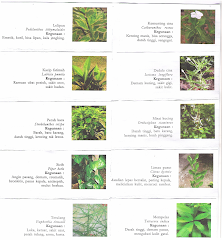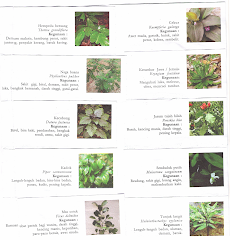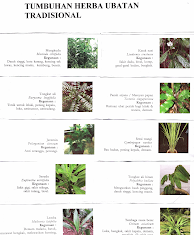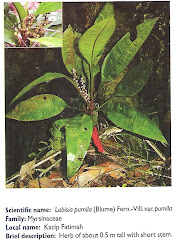Right now, people are conserving the Tropical Rain Forests by ecotourism and rehabilitaion. Ecotourism is giving people tours of the forest and showing them what we are losing by cutting them down. We are helping them even more by rebuilding and restarting forests in certain areas.
By speaking with the local people living in, and around, the rainforest, conservationists can learn information that would allow them to best focus their conservation efforts 3.
Another way conservation has become the most economically beneficial option is through carbon credits. Under the Kyoto Protocol, countries must reduce their emissions of Carbon Dioxide by 5% below the 1990 levels before 2012. Countries can meet their mandatory cuts in emissions by offsetting some of those emissions some other way. Through conservation or reforestation of the rainforest, countries can receive credits.
Some worldwide companies have stated publicly that they won't buy products that come from recently cleared areas of the rainforest. [1]
It's important to conserve the rainforest because many resources for things we use everyday come from the rainforest, including rubber for tires and spices such as cinnamon and many other common items. [2] The rainforest also needs to be conserved because the earth needs trees to take in carbon dioxide. About 1/4 of the world's greenhouse gas emissions come from deforestation [3]
Deforestation is the clearance of naturally occurring forests by logging and burning.
Deforestation occurs for many reasons: trees or derived charcoal are used as, or sold, for fuel or as a commodity, while cleared land is used as pasture for livestock, plantations of commodities, and settlements. The removal of trees without sufficient reforestation has resulted in damage to habitat, biodiversity loss and aridity. It has adverse impacts on biosequestration of atmospheric carbon dioxide. Deforested regions typically incur significant adverse soil erosion and frequently degrade into wasteland.
Disregard or ignorance of intrinsic value, lack of ascribed value, lax forest management and deficient environmental law are some of the factors that allow deforestation to occur on a large scale. In many countries, deforestation is an ongoing issue that is causing extinction, changes to climatic conditions, desertification, and displacement of indigenous people.
Among countries with a per capita GDP of at least US$4,600, net deforestation rates have ceased to increase.
There are many root causes of contemporary deforestation, including corruption of government institutions,[3][4] the inequitable distribution of wealth and power,[5] population growth[6] and overpopulation,[7][8] and urbanization.[9] Globalization is often viewed as another root cause of deforestation,[10][11] though there are cases in which the impacts of globalization (new flows of labor, capital, commodities, and ideas) have promoted localized forest recovery.[12]
In 2000 the United Nations Food and Agriculture Organization (FAO) found that "the role of population dynamics in a local setting may vary from decisive to negligible," and that deforestation can result from "a combination of population pressure and stagnating economic, social and technological conditions."[6]
According to the United Nations Framework Convention on Climate Change (UNFCCC) secretariat, the overwhelming direct cause of deforestation is agriculture. Subsistence farming is responsible for 48% of deforestation; commercial agriculture is responsible for 32% of deforestation; logging is responsible for 14% of deforestation and fuel wood removals make up 5% of deforestation.[13]
The degradation of forest ecosystems has also been traced to economic incentives that make forest conversion appear more profitable than forest conservation.[14] Many important forest functions have no markets, and hence, no economic value that is readily apparent to the forests' owners or the communities that rely on forests for their well-being.[14] From the perspective of the developing world, the benefits of forest as carbon sinks or biodiversity reserves go primarily to richer developed nations and there is insufficient compensation for these services. Developing countries feel that some countries in the developed world, such as the United States of America, cut down their forests centuries ago and benefited greatly from this deforestation, and that it is hypocritical to deny developing countries the same opportunities: that the poor shouldn't have to bear the cost of preservation when the rich created the problem.[15]
Experts do not agree on whether industrial logging is an important contributor to global deforestation.[16][17] Similarly, there is no consensus on whether poverty is important in deforestation. Some argue that poor people are more likely to clear forest because they have no alternatives, others that the poor lack the ability to pay for the materials and labour needed to clear forest.[16] Claims that population growth drives deforestation have been disputed;[16] one study found that population increases due to high fertility rates were a primary driver of tropical deforestation in only 8% of cases.[18]
Some commentators have noted a shift in the drivers of deforestation over the past 30 years.[19] Whereas deforestation was primarily driven by subsistence activities and government-sponsored development projects like transmigration in countries like Indonesia and colonization in Latin America, India, Java etc during late 19th century and the earlier half of the 20th century. By the 1990s the majority of deforestation was caused by industrial factors, including extractive industries, large-scale cattle ranching, and extensive agriculture.[20]
Atmospheric
Deforestation is ongoing and is shaping climate and geography.[21][22][23][24]
Deforestation is a contributor to global warming,[25][26] and is often cited as one of the major causes of the enhanced greenhouse effect. Tropical deforestation is responsible for approximately 20% of world greenhouse gas emissions.[27] According to the Intergovernmental Panel on Climate Change deforestation, mainly in tropical areas, could account for up to one-third of total anthropogenic carbon dioxide emissions.[28] But recent calculations suggest that carbon dioxide emissions from deforestation and forest degradation (excluding peatland emissions) contribute about 12% of total anthropogenic carbon dioxide emissions with a range from 6 to 17%.[29] Trees and other plants remove carbon (in the form of carbon dioxide) from the atmosphere during the process of photosynthesis and release oxygen back into the atmosphere during normal respiration. Only when actively growing can a tree or forest remove carbon over an annual or longer timeframe. Both the decay and burning of wood releases much of this stored carbon back to the atmosphere. In order for forests to take up carbon, the wood must be harvested and turned into long-lived products and trees must be re-planted.[30] Deforestation may cause carbon stores held in soil to be released. Forests are stores of carbon and can be either sinks or sources depending upon environmental circumstances. Mature forests alternate between being net sinks and net sources of carbon dioxide (see carbon dioxide sink and carbon cycle).
Reducing emissions from the tropical deforestation and forest degradation (REDD) in developing countries has emerged as new potential to complement ongoing climate policies. The idea consists in providing financial compensations for the reduction of greenhouse gas (GHG) emissions from deforestation and forest degradation".[31]
Rainforests are widely believed by laymen to contribute a significant amount of world's oxygen,[32] although it is now accepted by scientists that rainforests contribute little net oxygen to the atmosphere and deforestation will have no effect on atmospheric oxygen levels.[33][34] However, the incineration and burning of forest plants to clear land releases large amounts of CO2, which contributes to global warming.[26]
Forests are also able to extract carbon dioxide and pollutants from the air, thus contributing to biosphere stability.[citation needed]
Hydrological
The water cycle is also affected by deforestation. Trees extract groundwater through their roots and release it into the atmosphere. When part of a forest is removed, the trees no longer evaporate away this water, resulting in a much drier climate. Deforestation reduces the content of water in the soil and groundwater as well as atmospheric moisture.[35] Deforestation reduces soil cohesion, so that erosion, flooding and landslides ensue.[36][37] Forests enhance the recharge of aquifers in some locales, however, forests are a major source of aquifer depletion on most locales.[38]
Shrinking forest cover lessens the landscape's capacity to intercept, retain and transpire precipitation. Instead of trapping precipitation, which then percolates to groundwater systems, deforested areas become sources of surface water runoff, which moves much faster than subsurface flows. That quicker transport of surface water can translate into flash flooding and more localized floods than would occur with the forest cover. Deforestation also contributes to decreased evapotranspiration, which lessens atmospheric moisture which in some cases affects precipitation levels down wind from the deforested area, as water is not recycled to downwind forests, but is lost in runoff and returns directly to the oceans. According to one preliminary study, in deforested north and northwest China, the average annual precipitation decreased by one third between the 1950s and the 1980s.[citation needed]
Trees, and plants in general, affect the water cycle significantly:
• their canopies intercept a proportion of precipitation, which is then evaporated back to the atmosphere (canopy interception);
• their litter, stems and trunks slow down surface runoff;
• their roots create macropores - large conduits - in the soil that increase infiltration of water;
• they contribute to terrestrial evaporation and reduce soil moisture via transpiration;
• their litter and other organic residue change soil properties that affect the capacity of soil to store water.
• their leaves control the humidity of the atmosphere by transpiring. 99% of the water absorbed by the roots moves up to the leaves and is transpired.[39]
As a result, the presence or absence of trees can change the quantity of water on the surface, in the soil or groundwater, or in the atmosphere. This in turn changes erosion rates and the availability of water for either ecosystem functions or human services.
The forest may have little impact on flooding in the case of large rainfall events, which overwhelm the storage capacity of forest soil if the soils are at or close to saturation.
Tropical rainforests produce about 30% of our planet's fresh water.[32]
Soil
Undisturbed forest has very low rates of soil loss, approximately 2 metric tons per square kilometer (6 short tons per square mile).[citation needed] Deforestation generally increases rates of soil erosion, by increasing the amount of runoff and reducing the protection of the soil from tree litter. This can be an advantage in excessively leached tropical rain forest soils. Forestry operations themselves also increase erosion through the development of roads and the use of mechanized equipment.
China's Loess Plateau was cleared of forest millennia ago. Since then it has been eroding, creating dramatic incised valleys, and providing the sediment that gives the Yellow River its yellow color and that causes the flooding of the river in the lower reaches (hence the river's nickname 'China's sorrow').
Removal of trees does not always increase erosion rates. In certain regions of southwest US, shrubs and trees have been encroaching on grassland. The trees themselves enhance the loss of grass between tree canopies. The bare intercanopy areas become highly erodible. The US Forest Service, in Bandelier National Monument for example, is studying how to restore the former ecosystem, and reduce erosion, by removing the trees.
Tree roots bind soil together, and if the soil is sufficiently shallow they act to keep the soil in place by also binding with underlying bedrock. Tree removal on steep slopes with shallow soil thus increases the risk of landslides, which can threaten people living nearby. However most deforestation only affects the trunks of trees, allowing for the roots to stay rooted, negating the landslide.
Ecological
Deforestation results in declines in biodiversity.[40] The removal or destruction of areas of forest cover has resulted in a degraded environment with reduced biodiversity.[41] Forests support biodiversity, providing habitat for wildlife;[42] moreover, forests foster medicinal conservation.[43] With forest biotopes being irreplaceable source of new drugs (such as taxol), deforestation can destroy genetic variations (such as crop resistance) irretrievably.[44]
Since the tropical rainforests are the most diverse ecosystems on Earth[45][46] and about 80% of the world's known biodiversity could be found in tropical rainforests,[47][48] removal or destruction of significant areas of forest cover has resulted in a degraded[49] environment with reduced biodiversity.[50]
Scientific understanding of the process of extinction is insufficient to accurately make predictions about the impact of deforestation on biodiversity.[51] Most predictions of forestry related biodiversity loss are based on species-area models, with an underlying assumption that as forest are declines species diversity will decline similarly.[52] However, many such models have been proven to be wrong and loss of habitat does not necessarily lead to large scale loss of species.[52] Species-area models are known to overpredict the number of species known to be threatened in areas where actual deforestation is ongoing, and greatly overpredict the number of threatened species that are widespread.[53]
It has been estimated that we are losing 137 plant, animal and insect species every single day due to rainforest deforestation, which equates to 50,000 species a year.[54] Others state that tropical rainforest deforestation is contributing to the ongoing Holocene mass extinction.[55][56] The known extinction rates from deforestation rates are very low, approximately 1 species per year from mammals and birds which extrapolates to approximately 23,000 species per year for all species. Predictions have been made that more than 40% of the animal and plant species in Southeast Asia could be wiped out in the 21st century.[57] Such predictions were called into question by 1995 data that show that within regions of Southeast Asia much of the original forest has been converted to monospecific plantations, but that potentially endangered species are few and tree flora remains widespread and stable.[53]
Economic impact
Damage to forests and other aspects of nature could halve living standards for the world's poor and reduce global GDP by about 7% by 2050, a major report concluded at the Convention on Biological Diversity (CBD) meeting in Bonn.[58] Historically utilization of forest products, including timber and fuel wood, have played a key role in human societies, comparable to the roles of water and cultivable land. Today, developed countries continue to utilize timber for building houses, and wood pulp for paper. In developing countries almost three billion people rely on wood for heating and cooking.[59]
The forest products industry is a large part of the economy in both developed and developing countries. Short-term economic gains made by conversion of forest to agriculture, or over-exploitation of wood products, typically leads to loss of long-term income and long term biological productivity (hence reduction in nature's services). West Africa, Madagascar, Southeast Asia and many other regions have experienced lower revenue because of declining timber harvests. Illegal logging causes billions of dollars of losses to national economies annually.[60]
The new procedures to get amounts of wood are causing more harm to the economy and overpowers the amount of money spent by people employed in logging.[61] According to a study, "in most areas studied, the various ventures that prompted deforestation rarely generated more than US$5 for every ton of carbon they released and frequently returned far less than US$1". The price on the European market for an offset tied to a one-ton reduction in carbon is 23 euro (about US$35).[62]
The forest area change may follow a pattern suggested by the forest transition (FT) theory, whereby at early stages in its development a country is characterized by high forest cover and low deforestation rates (HFLD countries) [See Mather 1992; Rudel et al. 2005; Chomitz et al. 2006; and Angelsen 2007]
Then deforestation rates accelerate (HFHD, high forest cover - high deforestation rate), and forest cover is reduced (LFHD. low forest cover - high deforestation rate), before the deforestation rate slows (LFLD, low forest cover - low deforestation rate), after which forest cover stabilizes and eventually starts recovering. FT is not a “law of nature,” and the pattern is infuenced by national context (e.g., human population density, stage of development, structure of the economy), global economic forces, and government policies. A country may reach very low levels of forest cover before it stabilizes, or it might through good policies be able to “bridge” the forest transition.
FT depicts a broad trend, and an extrapolation of historical rates therefore tends to underestimate future BAU deforestation for counties at the early stages in the transition (HFLD), while it tends to overestimate BAU deforestation for countries at the later stages (LFHD and LFLD).
Countries with high forest cover can be expected to be at early stages of the FT. GDP per capita captures the stage in a country’s economic development, which is linked to the pattern of natural resource use, including forests. The choice of forest cover and GDP per capita also fits well with the two key scenarios in the FT:
(i) a forest scarcity path, where forest scarcity triggers forces (e.g., higher prices of forest products) that lead to forest cover stabilization; and
(ii) an economic development path, where new and better off-farm employment opportunities associated with economic growth (= increasing GDP per capita) reduce profitability of frontier agriculture and slows deforestation. [Rudel et al. 2005]
Small scale deforestation was practiced by some societies for tens of thousands of years before the beginnings of civilization.[63] The first evidence of deforestation appears in the Mesolithic period.[64] It was probably used to convert closed forests into more open ecosystems favourable to game animals.[63] With the advent of agriculture, larger areas began to be deforested, and fire became the prime tool to clear land for crops. In Europe there is little solid evidence before 7000 BC. Mesolithic foragers used fire to create openings for red deer and wild boar. In Great Britain, shade-tolerant species such as oak and ash are replaced in the pollen record by hazels, brambles, grasses and nettles. Removal of the forests led to decreased transpiration, resulting in the formation of upland peat bogs. Widespread decrease in elm pollen across Europe between 8400-8300 BC and 7200-7000 BC, starting in southern Europe and gradually moving north to Great Britain, may represent land clearing by fire at the onset of Neolithic agriculture.
The Neolithic period saw extensive deforestation for farming land.[65][66] Stone axes were being made from about 3000 BC not just from flint, but from a wide variety of hard rocks from across Britain and North America as well. They include the noted Langdale axe industry in the English Lake District, quarries developed at Penmaenmawr in North Wales and numerous other locations. Rough-outs were made locally near the quarries, and some were polished locally to give a fine finish. This step not only increased the mechanical strength of the axe, but also made penetration of wood easier. Flint was still used from sources such as Grimes Graves but from many other mines across Europe.
Evidence of deforestation has been found in Minoan Crete; for example the environs of the Palace of Knossos were severely deforested in the Bronze Age.[67]
Pre-industrial history
Throughout most of history, humans were hunter gatherers who hunted within forests. In most areas, such as the Amazon, the tropics, Central America, and the Caribbean,[68] only after shortages of wood and other forest products occur are policies implemented to ensure forest resources are used in a sustainable manner.
In ancient Greece, Tjeered van Andel and co-writers[69] summarized three regional studies of historic erosion and alluviation and found that, wherever adequate evidence exists, a major phase of erosion follows, by about 500-1,000 years the introduction of farming in the various regions of Greece, ranging from the later Neolithic to the Early Bronze Age. The thousand years following the mid-first millennium BCE saw serious, intermittent pulses of soil erosion in numerous places. The historic silting of ports along the southern coasts of Asia Minor (e.g. Clarus, and the examples of Ephesus, Priene and Miletus, where harbors had to be abandoned because of the silt deposited by the Meander) and in coastal Syria during the last centuries BC.
Easter Island has suffered from heavy soil erosion in recent centuries, aggravated by agriculture and deforestation.[70] Jared Diamond gives an extensive look into the collapse of the ancient Easter Islanders in his book Collapse. The disappearance of the island's trees seems to coincide with a decline of its civilization around the 17th and 18th century. He attributed the collapse to deforestation and over-exploitation of all resources.[71][72]
The famous silting up of the harbor for Bruges, which moved port commerce to Antwerp, also followed a period of increased settlement growth (and apparently of deforestation) in the upper river basins. In early medieval Riez in upper Provence, alluvial silt from two small rivers raised the riverbeds and widened the floodplain, which slowly buried the Roman settlement in alluvium and gradually moved new construction to higher ground; concurrently the headwater valleys above Riez were being opened to pasturage.[cit
A typical progress trap was that cities were often built in a forested area, which would provide wood for some industry (e.g. construction, shipbuilding, pottery). When deforestation occurs without proper replanting, however; local wood supplies become difficult to obtain near enough to remain competitive, leading to the city's abandonment, as happened repeatedly in Ancient Asia Minor. Because of fuel needs, mining and metallurgy often led to deforestation and city abandonment.[citation needed]
With most of the population remaining active in (or indirectly dependent on) the agricultural sector, the main pressure in most areas remained land clearing for crop and cattle farming. Enough wild green was usually left standing (and partially used, e.g. to collect firewood, timber and fruits, or to graze pigs) for wildlife to remain viable. The elite's (nobility and higher clergy)protection of their own hunting privileges and game often protected significant woodlands.[citation needed]
Major parts in the spread (and thus more durable growth) of the population were played by monastical 'pioneering' (especially by the Benedictine and Commercial orders) and some feudal lords' recruiting farmers to settle (and become tax payers) by offering relatively good legal and fiscal conditions. Even when speculators sought to encourage towns, settlers needed an agricultural belt around or sometimes within defensive walls. When populations were quickly decreased by causes such as the Black Death or devastating warfare (e.g. Genghis Khan's Mongol hordes in eastern and central Europe, Thirty Years' War in Germany), this could lead to settlements being abandoned. The land was reclaimed by nature, but the secondary forests usually lacked the original biodiversity.
From 1100 to 1500 AD, significant deforestation took place in Western Europe as a result of the expanding human population. The large-scale building of wooden sailing ships by European (coastal) naval owners since the 15th century for exploration, colonisation, slave trade–and other trade on the high seas consumed many forest resources. Piracy also contributed to the over harvesting of forests, as in Spain. This led to a weakening of the domestic economy after Columbus' discovery of America, as the economy became dependent on colonial activities (plundering, mining, cattle, plantations, trade, etc.)[citation needed]
In Changes in the Land (1983), William Cronon analyzed and documented 17th-century English colonists' reports of increased seasonal flooding in New England during the period when new settlers initially cleared the forests for agriculture. They believed flooding was linked to widespread forest clearing upstream.
The massive use of charcoal on an industrial scale in Early Modern Europe was a new type of consumption of western forests; even in Stuart England, the relatively primitive production of charcoal has already reached an impressive level. Stuart England was so widely deforested that it depended on the Baltic trade for ship timbers, and looked to the untapped forests of New England to supply the need. Each of Nelson's Royal Navy war ships at Trafalgar (1805) required 6,000 mature oaks for its construction. In France, Colbert planted oak forests to supply the French navy in the future. When the oak plantations matured in the mid-nineteenth century, the masts were no longer required because shipping had changed.
Norman F. Cantor's summary of the effects of late medieval deforestation applies equally well to Early Modern Europe:[73]
Europeans had lived in the midst of vast forests throughout the earlier medieval centuries. After 1250 they became so skilled at deforestation that by 1500 they were running short of wood for heating and cooking. They were faced with a nutritional decline because of the elimination of the generous supply of wild game that had inhabited the now-disappearing forests, which throughout medieval times had provided the staple of their carnivorous high-protein diet. By 1500 Europe was on the edge of a fuel and nutritional disaster [from] which it was saved in the sixteenth century only by the burning of soft coal and the cultivation of potatoes and maize.
Industrial era
In the 19th century, introduction of steamboats in the United States was the cause of deforestation of banks of major rivers, such as the Mississippi River, with increased and more severe flooding one of the environmental results. The steamboat crews cut wood every day from the riverbanks to fuel the steam engines. Between St. Louis and the confluence with the Ohio River to the south, the Mississippi became more wide and shallow, and changed its channel laterally. Attempts to improve navigation by the use of snagpullers often resulted in crews' clearing large trees 100 to 200 feet back from the banks. Several French colonial towns of the Illinois Country, such as Kaskaskia, Cahokia and St. Philippe, Illinois were flooded and abandoned in the late 19th century, with a loss to the cultural record of their archeology.[74]
Specific parallels are seen in the twentieth-century deforestation occurring in many developing nations.
Global deforestation sharply accelerated around 1852.[75][76] It has been estimated that about half of the Earth's mature tropical forests—between 7.5 million and 8 million km2 (2.9 million to 3 million sq mi) of the original 15 million to 16 million km2 (5.8 million to 6.2 million sq mi) that until 1947 covered the planet[77]—have now been cleared.[78][79] Some scientists have predicted that unless significant measures (such as seeking out and protecting old growth forests that have not been disturbed)[77] are taken on a worldwide basis, by 2030 there will only be ten percent remaining,[75][78] with another ten percent in a degraded condition.[75] 80% will have been lost, and with them hundreds of thousands of irreplaceable species.[75]
The difficulties of estimating deforestation rates are nowhere more apparent than in the widely varying estimates of rates of rainforest deforestation. Some environmental groups argue that one fifth of the world's tropical rainforest was destroyed between 1960 and 1990, that rainforests 50 years ago covered 14% of the world's land surface and have been reduced to 6%,[54] and that all tropical forests will be gone by 2090.[54] Meanwhile, Alan Grainger of Leeds University argues that there is no credible evidence of any long-term decline in rainforest area.[80] Bjørn Lomborg, author of The Skeptical Environmentalist, claims that global forest cover has remained approximately stable since the middle of the twentieth century.[81][82] Along similar lines, some have claimed that for every acre of rain forest cut down each year, more than 50 acres (20 ha) of new forest are growing in the tropics.[83]
These divergent viewpoints are the result of the uncertainties in the extent of tropical deforestation. For tropical countries, deforestation estimates are very uncertain and could be in error by as much as +/- 50%,[84] while a 2002 analysis of satellite imagery suggested that the rate of deforestation in the humid tropics (approximately 5.8 million hectares per year) was roughly 23% lower than the most commonly quoted rates.[85] Conversely, a new analysis of satellite images reveals that deforestation of the Amazon rainforest is twice as fast as scientists previously estimated.[86][87]
Some have argued that deforestation trends may follow a Kuznets curve,[88] which if true would nonetheless fail to eliminate the risk of irreversible loss of non-economic forest values (e.g., the extinction of species).[89][90]
A 2005 report by the United Nations Food and Agriculture Organization (FAO) estimates that although the Earth's total forest area continues to decrease at about 13 million hectares per year, the global rate of deforestation has recently been slowing.[91][92] Still others claim that rainforests are being destroyed at an ever-quickening pace.[93] The London-based Rainforest Foundation notes that "the UN figure is based on a definition of forest as being an area with as little as 10% actual tree cover, which would therefore include areas that are actually savannah-like ecosystems and badly damaged forests."[94] Other critics of the FAO data point out that they do not distinguish between forest types,[95] and that they are based largely on reporting from forestry departments of individual countries,[96] which do not take into account unofficial activities like illegal logging.[97]
Despite these uncertainties, there is agreement that destruction of rainforests remains a significant environmental problem. Up to 90% of West Africa's coastal rainforests have disappeared since 1900.[98] In South Asia, about 88% of the rainforests have been lost.[99] Much of what remains of the world's rainforests is in the Amazon basin, where the Amazon Rainforest covers approximately 4 million square kilometres.[100] The regions with the highest tropical deforestation rate between 2000 and 2005 were Central America—which lost 1.3% of its forests each year—and tropical Asia.[94] In Central America, two-thirds of lowland tropical forests have been turned into pasture since 1950 and 40% of all the rainforests have been lost in the last 40 years.[101] Brazil has lost 90-95% of its Mata Atlântica forest.[102] Madagascar has lost 90% of its eastern rainforests.[103][104] As of 2007, less than 1% of Haiti's forests remained.[105] Mexico, India, the Philippines, Indonesia, Thailand, Myanmar, Malaysia, Bangladesh, China, Sri Lanka, Laos, Nigeria, the Democratic Republic of the Congo, Liberia, Guinea, Ghana and the Côte d'Ivoire, have lost large areas of their rainforest.[106][107] Several countries, notably Brazil, have declared their deforestation a national emergency.[108
Major international organizations, including the United Nations and the World Bank, have begun to develop programs aimed at curbing deforestation. The blanket term Reducing Emissions from Deforestation and Forest Degradation (REDD) describes these sorts of programs, which use direct monetary or other incentives to encourage developing countries to limit and/or roll back deforestation. Funding has been an issue, but at the UN Framework Convention on Climate Change (UNFCCC) Conference of the Parties-15 (COP-15) in Copenhagen in December 2009, an accord was reached with a collective commitment by developed countries for new and additional resources, including forestry and investments through international institutions, that will approach USD 30 billion for the period 2010 - 2012.[110] Significant work is underway on tools for use in monitoring developing country adherence to their agreed REDD targets. These tools, which rely on remote forest monitoring using satellite imagery and other data sources, include the Center for Global Development's FORMA (Forest Monitoring for Action) initiative [2] and the Group on Earth Observations' Forest Carbon Tracking Portal [3]. Methodological guidance for forest monitoring was also emphasized at COP-15 [111]
[edit] Farming
New methods are being developed to farm more intensively, such as high-yield hybrid crops, greenhouse, autonomous building gardens, and hydroponics. These methods are often dependent on chemical inputs to maintain necessary yields. In cyclic agriculture, cattle are grazed on farm land that is resting and rejuvenating. Cyclic agriculture actually increases the fertility of the soil. Intensive farming can also decrease soil nutrients by consuming at an accelerated rate the trace minerals needed for crop growth.[citation needed]
Forest management
Efforts to stop or slow deforestation have been attempted for many centuries because it has long been known that deforestation can cause environmental damage sufficient in some cases to cause societies to collapse. In Tonga, paramount rulers developed policies designed to prevent conflicts between short-term gains from converting forest to farmland and long-term problems forest loss would cause,[112] while during the seventeenth and eighteenth centuries in Tokugawa, Japan,[113] the shoguns developed a highly sophisticated system of long-term planning to stop and even reverse deforestation of the preceding centuries through substituting timber by other products and more efficient use of land that had been farmed for many centuries. In sixteenth century Germany landowners also developed silviculture to deal with the problem of deforestation. However, these policies tend to be limited to environments with good rainfall, no dry season and very young soils (through volcanism or glaciation). This is because on older and less fertile soils trees grow too slowly for silviculture to be economic, whilst in areas with a strong dry season there is always a risk of forest fires destroying a tree crop before it matures.
In the areas where "slash-and-burn" is practiced, switching to "slash-and-char" would prevent the rapid deforestation and subsequent degradation of soils. The biochar thus created, given back to the soil, is not only a durable carbon sequestration method, but it also is an extremely beneficial amendment to the soil. Mixed with biomass it brings the creation of terra preta, one of the richest soils on the planet and the only one known to regenerate itself.
Certification of sustainable forest management practices
Certification, as provided by global certification systems such as PEFC and FSC, contributes to tackling deforestation by creating market demand for timber from sustainably managed forests. According to the United Nations Food and Agriculture Organization (FAO), "A major condition for the adoption of sustainable forest management is a demand for products that are produced sustainably and consumer willingness to pay for the higher costs entailed. Certification represents a shift from regulatory approaches to market incentives to promote sustainable forest management. By promoting the positive attributes of forest products from sustainably managed forests, certification focuses on the demand side of environmental conservation."[114]
Reforestation
Main article: Reforestation
In many parts of the world, especially in East Asian countries, reforestation and afforestation are increasing the area of forested lands.[115] The amount of woodland has increased in 22 of the world's 50 most forested nations. Asia as a whole gained 1 million hectares of forest between 2000 and 2005. Tropical forest in El Salvador expanded more than 20% between 1992 and 2001. Based on these trends, one study projects that global forest will increase by 10%—an area the size of India—by 2050.[116]
In the People's Republic of China, where large scale destruction of forests has occurred, the government has in the past required that every able-bodied citizen between the ages of 11 and 60 plant three to five trees per year or do the equivalent amount of work in other forest services. The government claims that at least 1 billion trees have been planted in China every year since 1982. This is no longer required today, but March 12 of every year in China is the Planting Holiday. Also, it has introduced the Green Wall of China project, which aims to halt the expansion of the Gobi desert through the planting of trees. However, due to the large percentage of trees dying off after planting (up to 75%), the project is not very successful.[citation needed] There has been a 47-million-hectare increase in forest area in China since the 1970s.[116] The total number of trees amounted to be about 35 billion and 4.55% of China's land mass increased in forest coverage. The forest coverage was 12% two decades ago and now is 16.55%.[117]
An ambitious proposal for China is the Aerially Delivered Re-forestation and Erosion Control System and the Proposed sahara forest project coupled with the Seawater Greenhouse.
In Western countries, increasing consumer demand for wood products that have been produced and harvested in a sustainable manner is causing forest landowners and forest industries to become increasingly accountable for their forest management and timber harvesting practices.
The Arbor Day Foundation's Rain Forest Rescue program is a charity that helps to prevent deforestation. The charity uses donated money to buy up and preserve rainforest land before the lumber companies can buy it. The Arbor Day Foundation then protects the land from deforestation. This also locks in the way of life of the primitive tribes living on the forest land. Organizations such as Community Forestry International, Cool Earth, The Nature Conservancy, World Wide Fund for Nature, Conservation International, African Conservation Foundation and Greenpeace also focus on preserving forest habitats. Greenpeace in particular has also mapped out the forests that are still intact [4] and published this information on the internet.[118] HowStuffWorks in turn has made a simpler thematic map[119] showing the amount of forests present just before the age of man (8000 years ago) and the current (reduced) levels of forest.[120] These maps mark the amount of afforestation required to repair the damage caused by man. Forest plantations
To meet the world's demand for wood, it has been suggested by forestry writers Botkins and Sedjo that high-yielding forest plantations are suitable. It has been calculated that plantations yielding 10 cubic meters per hectare annually could supply all the timber required for international trade on 5% of the world's existing forestland. By contrast, natural forests produce about 1-2 cubic meters per hectare; therefore, 5 to 10 times more forestland would be required to meet demand. Forester Chad Oliver has suggested a forest mosaic with high-yield forest lands interpersed with conservation land.[121]
One analysis of FAO data suggests that afforestation and reforestation projects "could reverse the global decline in woodlands within 30 years."[122]
Reforestation through tree planting could take advantage of changing precipitation patterns due to climate change. This would be done by studying where precipitation is projected to increase (see the "2050 Precipitation" thematic map created by Globalis) and setting up reforestation projects in these locations. Areas such as Niger, Sierra Leone and Liberia are especially important candidates because they also suffer from an expanding desert (the Sahara) and decreasing biodiversity (while being important biodiversity hotspots).
While the preponderance of deforestation is due to demands for agricultural and urban use for the human population, there are some examples of military causes. One example of deliberate deforestation is that which took place in the U.S. zone of occupation in Germany after World War II. Before the onset of the Cold War defeated Germany was still considered a potential future threat rather than potential future ally. To address this threat, attempts were made to lower German industrial potential, of which forests were deemed an element. Sources in the U.S. government admitted that the purpose of this was the "ultimate destruction of the war potential of German forests." As a consequence of the practice of clear-felling, deforestation resulted which could "be replaced only by long forestry development over perhaps a century."[123]
War can also be a cause of deforestation, either deliberately such as through the use of Agent Orange[124] during the Vietnam War where, together with bombs and bulldozers, it contributed to the destruction of 44% of the forest cover,[125] or inadvertently such as in the 1945 Battle of Okinawa where bombardment and other combat operations reduced the lush tropical landscape into "a vast field of mud, lead, decay and maggots".[126]
أَلَمْ تَرَ أَنَّ اللَّهَ يُسَبِّحُ لَهُ مَنْ فِي السَّمَاوَاتِ وَالأرْضِ وَالطَّيْرُ صَافَّاتٍ كُلٌّ قَدْ عَلِمَ صَلاتَهُ وَتَسْبِيحَهُ وَاللَّهُ عَلِيمٌ بِمَا يَفْعَلُونَ Tidakkah kamu tahu bahwasanya Allah: kepada-Nya bertasbih apa yang di langit dan di bumi dan (juga) burung dengan mengembangkan sayapnya. Masing-masing telah mengetahui (cara) solat dan tasbihnya, dan Allah Amat Mengetahui apa yang mereka kerjakan. an-Nur:41
Tazkirah
Sami Yusuf_try not to cry
mu'allim Muhammad Rasulullah Sallallahu alaihi waSalam
ummi_mak_mother_ibu_Sami Yusuf
zikir Tok Guru Nik Abdul Aziz Nik Mat Mu'allimul Mursyidi
syeikh masyari afasi
ruang rindu
song
Arisu Rozah
Usia 40

Mudah mudahan diluaskan rezeki anugerah Allah
usia 40 tahun

UPM

Kuatan Pahe Darul Makmur
pemakaian serban semsa menunaikan solat_InsyaAllah ada sawaaban anugerah Allah
Rempuh halangan

Abah_menyokong kuat oengajian Ijazah UPM

usia 39 tahun

usia 23 tahun_UPM
An_Namiru

Ijazah Pengurusan Hutan UPM

General Lumber_Nik Mahmud Nik Hasan

Chengal

Tauliah

Semasa tugas dgn general lumber

PALAPES UPM

UPM

Rumah yang lawa

Muhammad_Abdullah CD
semasa bermukim di Kuatan Pahe Darul Makmur
Ijazah

air terjun

Borneo land

GREEN PEACE
GREEN PEACE
Kelang

Ahlul Bayti_ Sayid Alawi Al Maliki

Asadu_ Tenang serta Berani

atTiflatul Falasthiniin

Sayid Muhammad Ahlul Bayt keturunan Rasulullah

AnNamiru_SAFARI_Kembara

AnNamiru_resting

Hamas

sabaha anNamiru fil nahri

Namir sedang membersih

Tok Guru Mualimul_Mursyid

An_Namiru
.jpg)
Namir_istirehat
.jpg)
SaaRa AnNamiru fil_Midan
.jpg)
Renungan Sang Harimau_Sabaha AnNamiru
.jpg)
Syaraba AnNamiru Ma_A
.jpg)
AnNamiru_Riadhah
.jpg)
AnNamiru_Riadhah
.jpg)
AnNimru ma_A waladuha
Namir fil_Ghabi (sebut Robi...
Namir

AdDubbu_Beruang di hutan

Amu Syahidan Wa La Tuba lil_A'duwwi

AsSyahid

Namir

Tangkas
najwa dan irah

sungai

najwa

najwa

Kaabatul musyarrafah

unta

Jabal Rahmah

masjid nabawi

masjid quba

dr.eg

najwa dan hadhirah

along[macho]
![along[macho]](https://blogger.googleusercontent.com/img/b/R29vZ2xl/AVvXsEjuMi7D33CmR0_KXrCW2XigfLcUuQurcvtqOS139ncCwEzCyB-jUopk7QK7anADIenJEm2S0N6gAY1ubnACYXewgiAsI3rBjnLTawM39alLL-rEopOoVqn0w5WpLhPJH3hrXNtchEhgtyaI/s240/P7150023.JPG)
harissa dan hadhirah

adik beradik
Tongkat Ali

Tongkat Ali
herba kacip Fatimah

herba Kacip Fatimah
hempedu beruang

hempedu beruang
hempedu bumi

hempedu bumi
herba misai kucing

herba misai kucing
herba tongkat Ali
.png)
Tongkat Ali
Ulama'

Ulama'
kapal terbang milik kerajaan negara ini yang dipakai pemimpin negara

kapal terbang
Adakah Insan ini Syahid

Syahid
Tok Ayah Haji Ismail

Saifuddin bersama Zakaria

Dinner....
Sukacita Kedatangan Tetamu
Pengikut
Kalimah Yang Baik

Ubi Jaga

Ubi Jaga
Arkib Blog
Burung Lang Rajawali

Chinese Sparrowhawk
Kelicap Mayang Kelapa

Brown-Throated Sunbird
Kopiah

Pokok Damar Minyak

Kacip Fatimah

Mengkudu Akar



